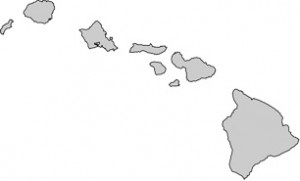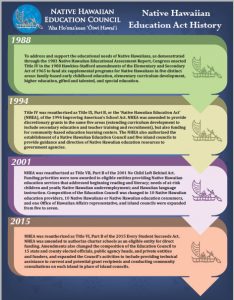As with anything, there is always a beginning, a seed that is planted. For the Native Hawaiian Education Council, this beginning was in 1988, with the passage of the Native Hawaiian Education Act, a piece of legislation which recognized the unique educational needs of the Native Hawaiian people and the role of the federal government in empowering Hawaiian organizations to address those needs.
In 1981, the Senate instructed the Office of Education to submit a comprehensive report on Native Hawaiian education. The Native Hawaiian Educational Assessment Project report, funded by the Kamehameha Schools Bishop Estate and submitted to Congress in 1983, found that Native Hawaiians scored below parity in education and that these low achievement levels were directly related to cultural factors. Hearings related to this report, held in 1984 and 1986 by the Select Committee on Indian Affairs, culminated in the enactment of Title IV of the ‘Augustus F. Hawkins-Robert T. Stafford Elementary and Secondary School Improvement Amendments of 1988,’ which authorized the development of supplemental educational programs to benefit Native Hawaiians.

Bishop Estate Trustee Myron B. Thompson, Senators Inouye and Akaka and the Hawai‘i Congressional Delegation were absolutely instrumental in the passage of the legislation, visiting every state representative and senator to gather support for Native Hawaiian programs and establish a trust relationship between the federal government and the Hawaiian people.
The legislation focused on improving the educational achievements of Native Hawaiians in five distinct areas: preschool, elementary (through curriculum development), special education, higher education, and gifted and talented. The Act initially funded six programs: The Kamehameha Schools Bishop Estate (KSBE) Family-Based Education Centers; ‘Aha Pūnana Leo, a Hawaiian language immersion preschool program; the KSBE Native Hawaiian Model Curriculum Implementation Project; Pihana Nā Mamo, a special education program within the State Department of Education; the Native Hawaiian Higher Education Program, administered by the KSBE; and Nā Pua No‘eau, an education program for the gifted and talented, administered by the University of Hawai‘i.
These programs were founded upon the principle that Native Hawaiians are a unique group and that utilization of culturally appropriate curriculum and teaching techniques stimulated and improved learning and retention, while also instilling a sense of pride in students. Moreover, these programs succeeded not only because they included, but emphasized the family and community in their activities.
It is important to note that the Native Hawaiian Health Care Improvement Act was also passed in 1988 due to the release of the E Ola Mau Reports, which was the first comprehensive study of Native Hawaiian health issues. This study indicated that Native Hawaiian communities were at a severe health disadvantage as compared to other ethnic groups of the Hawai‘i State population. This Act’s passage provided for the establishment of Papa Ola Lōkahi. Its reauthorization in 1992 established the Native Hawaiian Health Care System and the Native Hawaiian Health Scholarship Program.

History of NHEA | View here
In 1993, with the Native Hawaiian Education Act due for its first reauthorization, the U.S. Senate Committee on Indian Affairs, under Senator Daniel Inouye, held a series of meetings with the programs funded under NHEA and discovered that many individuals involved were meeting each other for the first time. Although their programs were serving the Hawaiian community, they were not interacting, nor sharing in the strengths and knowledge base that each possessed. A decision was thus made to host an education summit to create a forum for interaction within the Native Hawaiian education community, to assess current needs, share best practices, and plan for the future.
In April of 1993, the two-day Native Hawaiian Education Summit was convened, bringing together over two hundred Native Hawaiian educators, administrators, parents, students, and community members. This Summit provided the first opportunity for the community to assess the progress achieved under the Native Hawaiian Education Act during the five years since its passage. The ten-year update of the Native Hawaiian Educational Assessment Project was released during this time and was of great assistance in this process. It showed that while some progress had been made in certain areas, such as higher education for example, in general, Native Hawaiians continued to lag behind their counterparts.
‘Imi Na‘auao rekindles the light to guide the steps of our native people. We will continue to reconnect and recommit to the richness and dignity of our heritage, and with this inner strength, we will plan for the education of our people. With our ancestors guiding and anchoring our footsteps, the hope and vision of Hawaiian education is clear and limitless. -1993 Native Hawaiian Education Summit
Among the priority recommendations issued forth from the Summit was the establishment of a “… Native Hawaiian Education Board to ensure quality, accountability, coordination, and self-determination in all educational efforts for Native Hawaiians.” The concept was founded upon the recognition of a collective vision for the education of the Native Hawaiian community and a desire to move together towards common goals. – ‘Imi Na‘auao, Embracing Native Hawaiian Self-Determination through Educational Change
In 1994, in recognition of the continuing need for supplemental educational support, and in response to the recommendations that emerged from the Native Hawaiian Education Summit, Congress amended the Act, under the ‘Improving America’s Schools Act of 1994’ to: extend its authorization through the year 1999; provide for the creation of community-based education learning centers within rural Hawaiian communities; and expand Native Hawaiian curriculum development, teacher training and recruitment.
Despite the consequences of over 100 years of non-indigenous influence, the Native Hawaiian people are determined to preserve, develop, and transmit to future generations their ancestral territory, and their cultural identity in accordance with their own spiritual and traditional beliefs, customs, practices, language, and social institutions. -Native Hawaiian Education Act, Improving America’s Schools Act of 1994
Furthermore, the Act was amended to provide for the establishment of a Native Hawaiian Education Council to: “coordinate the educational and related services and programs available to Native Hawaiians, … assess the extent to which such services and programs meet the needs of Native Hawaiians; and provide direction and guidance, through the issuance of reports and recommendation, to appropriate Federal, State and local agencies to focus and improve the use of resources… on Native Hawaiian education.”
The Act required the Council to be made up of not more than 25 members from federal, state, and private educational organizations serving Native Hawaiians. To ensure adequate representation of island and community interests within the Council, the law authorized the Office of Hawaiian Affairs to facilitate the establishment of island councils for the following islands: (1) Hawai‘i; (2) Maui and Lāna‘i; (3) Moloka‘i; (4) Kaua‘i and Ni‘ihau; and (5) O‘ahu, and guaranteed each Island Council one seat on the state-wide Council. These Island Councils were to be made up of parents, students, and other community members who had an interest in the education of Native Hawaiians.
In January 1997, the Education Council was formed, followed shortly thereafter by the formation of the Island Councils in February. The Education Council met every quarter to consider matters of state-wide concern and also began the collection of information on what programs existed for Native Hawaiians. Members gathered to develop the Council’s vision and mission statements and outline a strategic plan. Most Island Councils met at least once a month to develop resource inventories of education programs serving their communities and identify the unique educational needs and concerns of their individual island communities.
The Native Hawaiian Education Act was reauthorized in 2001 as part of the ‘No Child Left Behind Act,’ and was grouped with legislation concerning Native American Education and Alaskan Native Education under Title VII. This revision changed the composition of the state council to include not more than 21 members, including at least ten education service providers and ten Native Hawaiian education consumers, as well as one representative from the Office of Hawaiian Affairs. Island councils were also reorganized to include: (1) Hawai‘i; (2) Maui; (3) Moloka‘i; (4) Lāna‘i; (5) O‘ahu; (6) Kaua‘i and (7) Ni‘ihau.
In December 2015, NHEA was reauthorized under the “Every Student Succeeds Act” as Title VI, Part B. One of the major amendments to the Act allowed charter schools to apply for direct funding from NHEA. Another major amendment changed the composition of the Council to 15 appointees from state and county offices, public agencies, Native Hawaiian-serving organizations, and private-funding entities. Furthermore, the Act no longer established the seven island councils, instead expanding Council activities to include conducting community consultations at least once a year on the islands of Hawai‘i, Kaua‘i, Lāna‘i, Maui, Moloka‘i, and O‘ahu to gather input from Native Hawaiian communities on current NHEA-funded programs and services, educational priorities and needs, and other education issues they face.
Today, the Native Hawaiian Education Council is an organization that is committed to the success of our students, in school and beyond. We strive to improve our communities through public outreach, data assessment, and technical assistance activities, always with the mission to ‘assess, evaluate, coordinate, report and make recommendations to perpetuate excellence in Native Hawaiian education.’